Taking 4K Gaming to the Limit: GTX 1080 Ti in SLI
Introduction
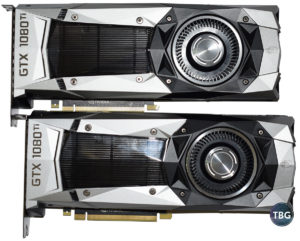
Here at TBG, we’ve done a number of 4K challenges over the years, starting with a GTX 980 Ti SLI setup, moving on to the GTX 1070 SLI setup, and finally the Titan X Pascal versus the GTX 1080 SLI setup. Well, thanks to the recent release of the GeForce GTX 1080 Ti, Nvidia has pushed gaming performance up a notch, so it’s time to benchmark 4K performance on two of these beasts running in SLI.
The truth is that the GTX 1080 Ti is probably the most important release for gamers in a very long time, but coming in the middle of a GPU generation, it’s made a bit less of a splash than previous product releases. The fact that it offered a tremendous performance boost over the GTX 1080 at the same price just 10 months later really didn’t make as much of an impact as it probably should have. It’s actually about 30% faster than the GTX 1080, which itself made a gigantic splash upon its release in May 2016 for besting the previous champ, the GTX 980 Ti, by about 30% at a slightly higher price. Comparing these two releases in context, then, the GTX 1080 Ti should have been the bigger deal. But in the end, our guess is that these mid-generation launches just can’t garner the kind of attention that big generational shifts do.
Well, we’re here to see if enthusiasts should get a bit more pumped about this card, specifically when run in SLI. We’re not going to give away the conclusion just yet… read on to find out if GTX 1080 Ti SLI is a must-have for serious 4K gamers!
Test Setup
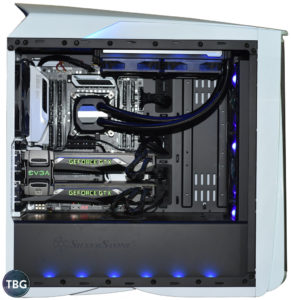
Here are the specs (and a photo) of the system we used for benchmarking:
- CPU: Intel Core i7-6900K, overclocked to 4.3GHz
- Motherboard: Asus X99-Pro/USB3.1
- Video Cards: 2x EVGA GeForce GTX 1080 Ti 11GB Founders Edition
- SLI Bridge: EVGA High-Bandwidth SLI Bridge 1-Slot
- RAM: Corsair 4x8GB Vengeance LPX DDR4-3200
- SSD #1: Samsung 950 Pro M.2 512GB
- SSD #2: Samsung 850 Evo 1TB
- Case: SilverStone Primera PM01
- Power Supply: EVGA Supernova 1000 PS
- CPU Cooler: Corsair Hydro H100i v2
- Operating System: Windows 10
- Monitor: LG 27UD68-P 27-Inch 4K
Note that we’ll be providing benchmarks for our 1080 Ti SLI duo at both reference and overclocked speeds. As with all Pascal cards, overclocking headroom of the GTX 1080 Ti is fairly limited; we were able to increase the core on our two samples by 160MHz (about 9%) and memory to 11,800MHz (up 7% from the reference 11,000MHz). Remember, when running in SLI, both cards must remain stable, so while one of our cards had a bit more headroom, we were limited by the lesser of the two samples. You can actually run them out of clock sync, but we don’t see that as being worthwhile. We ran our +160MHz/+800Mhz clocks in every single one of our games, and they never crashed a single time, but definitely crashed if we tried to push them any higher. We’re always suspicious of overclocking claims, even those done by professional reviewers, when the results are shown for just one or two games. That, dear readers, does not a valid overclock make!
To eliminate system bottlenecks as much as possible, we used our X99-based benchmarking system, which features an Intel Core i7-6900K processor was overclocked to 4.3GHz. As we found in our gaming CPU shootout, in many games, the extra power of this eight-core processor is critical to getting the most out of a high-end GPU configuration. For our testing, we’re using one synthetic benchmark and eight games, all running at a native 4K resolution: 3DMark Fire Strike Ultra, Crysis 3, Far Cry 4, The Witcher 3, Fallout 4, Rise of the Tomb Raider, DOOM, Battlefield 1, and Watch_Dogs 2. Each game was run with the highest preset available, typically referred to as “Very High” or “Ultra.” Note that in every game other than Battlefield 1, this is actually not the highest setting available, as individual parameters may have additional quality settings beyond Ultra, for example DOOM has a few “Nightmare” settings, and a number of games have extra ambient occlusion settings that aren’t included in any preset. For the sake of making comparisons easy, we decided it wasn’t worth it to max out each individual quality setting.
All game data was collected in actual in-game runs, which often provide totally different (and obviously more relevant) results than canned benchmarks. We used FRAPS to collect data for three 30-second samples of each benchmark on each video card setup. And take note: as always, we bench Battlefield 1 in a multiplayer round, which performs far differently from the single-player game that nearly ever other review site benchmarks but no one actually plays! Trust us when we say that getting reliable data in live BF1 matches takes almost as long as collecting all the other data combined, which is why you rarely see it done! We tested only at 4K because we truly believe that if you’re spending this much money on video cards, you should be gaming on a high-end monitor, which today means either 4K/60Hz or 1440p/100+Hz. As a rule of thumb, 2560 x 1440 runs twice as fast as 4K, so if you can hit 60fps at 4K, you can hit a high-refresh-friendly 120fps at 1440p. Have a 1080p monitor and want a GTX 1080 Ti? Get a new monitor first, please! As you’ll see, GTX 1080 Ti SLI is arguably too fast even for 4K!
Benchmarks
OK, now that we’ve explained the method to our madness, it’s time to move on to the results!
3DMark Fire Strike Ultra
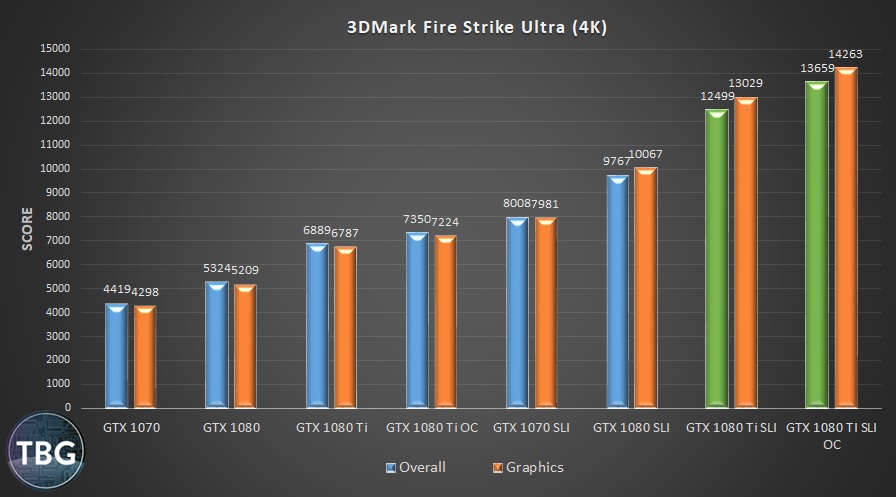
We start with 3DMark as always to provide a baseline for our analysis. Fire Strike Ultra runs natively in 4K, and is quite challenging for any modern system. We’re reporting the Overall and Graphics, dropping the Combined Score and Physics Score, as these are determined in part by the platform, which remained a constant throughout our testing. Right out of the gate, we can see that our 1080 Ti SLI setup is shockingly fast, besting the 1080 SLI duo by 29% and picking up another 9% boost once overclocked. When it comes to SLI setups, however, a lot of enthusiasts are rightfully most concerned about scaling, which is something we’ll highlight a number of times throughout this article. In 3DMark, the 1080 Ti SLI duo beats a single 1080 Ti by 92% at reference speeds and a surprising 97% once overclocked. Now, these are the kind of numbers that would get gamers to open up their wallets in droves, but we’re going to have to burst their bubble right off the bat… the 1080 Ti SLI duo wasn’t able to achieve this level of scaling in any one of our eight actual game tests, for reasons we’ll get into a bit later on after analyzing all the data.
Just one quick note: we’re highlighting the 1080 Ti SLI results in green throughout our charts just to make them easy to spot, but they’re directly comparable to all the other results.
Crysis 3

Crysis is as close to a universal PC benchmark as we’ve ever seen in an actual PC game. That’s why we keep it around, even though it was released way back in 2013. The fact that it can still bring systems to their knees is a testament to the skill of Crytek engineers, who were able to provide a view of the future of PC gaming with their advanced game engine. There’s no more obvious evidence of this than the spectacular scaling of SLI in this game. Despite the prodigious amount of GPU power that 1080 Ti SLI offers, we still see scaling of over 80%, and when overclocked, the 1080 Ti SLI duo actually hits 100fps, which is just mind-blowingly fast for a 4K result in this game. But there are signs even here of cracks forming in the 1080 Ti SLI’s armor, as the scaling falls off significantly versus the 1070 SLI setup, which was near 95%. The reason: CPU limitations are rearing their ugly head. You’ll hear more about this shortly….
Far Cry 4
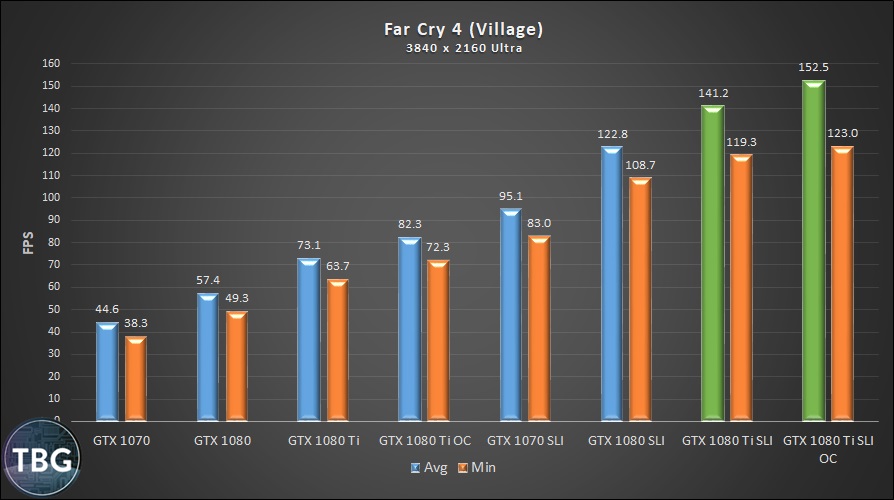
In Far Cry 4, we’ve seen the unusual result of SLI scaling at over 100% in various testing we’ve done, including on 1070 SLI and 1080 SLI. Well, with the 1080 Ti SLI setup scaling is still quite good, at 93% for the stock-clocked duo and 85% once the cards were overclocked, but again, we suspect a CPU limitation is getting in the way. Note that this game is very playable at 4K even with a single GTX 1080 Ti, so the SLI results are pretty wild – consider for example that they’re fast enough to max out unreleased 4K 144Hz monitors, which we anticipate will hit the market in late 2017!
Next, we’ll move on to a number of more recent games, all of which have pushed the limits of PC performance while also advancing the state of PC gaming generally.
Witcher 3
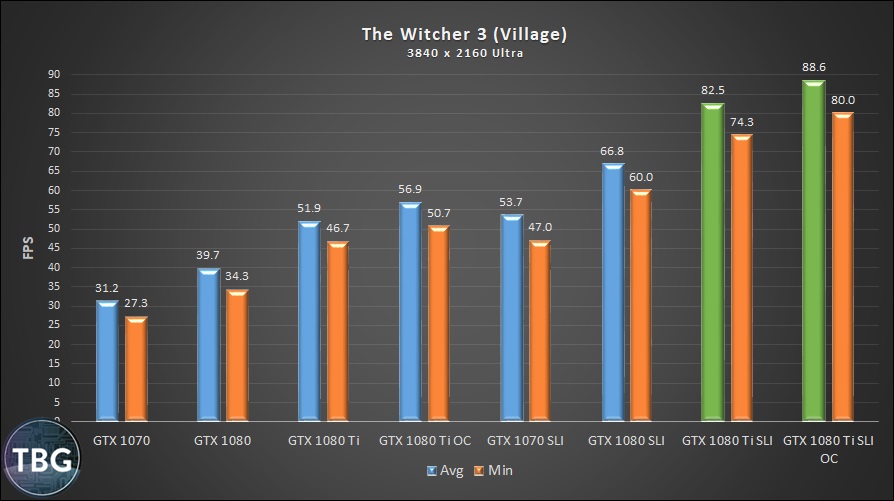
At 24% faster than the GTX 1080 SLI combo, 1080 Ti SLI blasts through this demanding game at 4K. But as with previous results, scaling is a little bit off the mark, dropping below 60% with 1080 Ti SLI, whereas it was above 70% for the weaker 1070 SLI combo. Evidence of a failure of SLI? Not at all, folks, though some may like to read the results that way to fend off an impulse buy!
Fallout 4
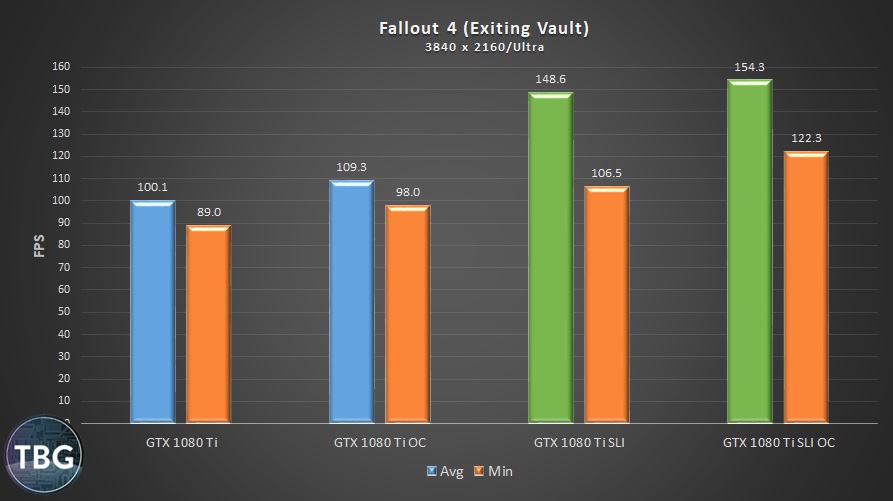
A funny thing happened while we were benching Fallout 4 for this article: we found framerates to go sky high, far higher than we’d ever seen before. Well, it turns out it wasn’t due to the magic of the 1080 Ti SLI combo, but rather the fact that our in-game benchmark had been played enough times that the scene switched over to night (Fallout 4 has dynamic day/night cycles). Since we don’t use canned benchmarks, we’re subject to the vagaries of real-world testing, and that meant we couldn’t include our results on the GTX 1070 and GTX 1080, which we’d collected previously when our game was still in the daytime mode, where the lighting model is far more complex (think tons of ambient occlusion to drain GPU power!).
Alas, with the high framerates we were hitting without daytime lighting in effect, SLI was significantly hampered in stretching its legs. There just wasn’t enough for the dynamic duo of GTX 1080 Ti GPUs to do. Scaling was around 50%. Of course, that was still good enough to hit the highest framerates of any of our benchmarks, and honestly speaking, absurdly fast for 4K monitors, which are currently limited to 60Hz.
Rise of the Tomb Raider
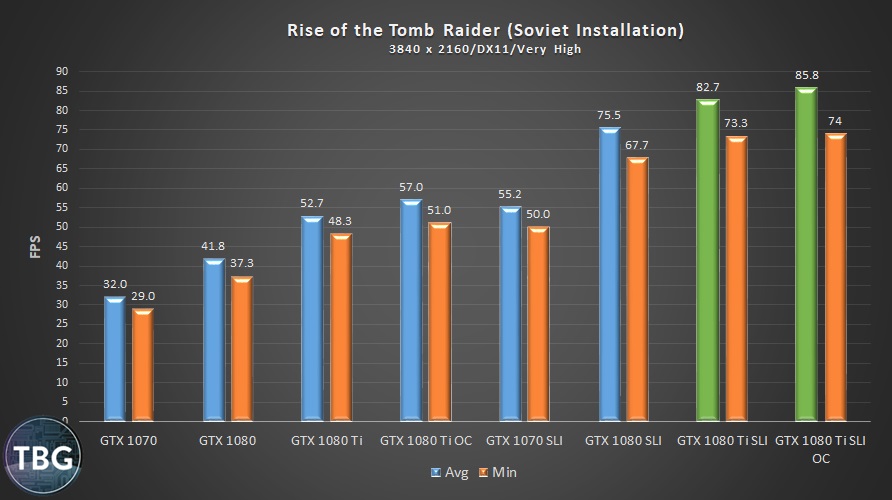
Rise of the Tomb Raider is traditionally viewed as completely GPU-limited, and we’ve found it to be a fantastic test of GPU power in the past. But oh boy, things are starting to look rough for GTX 1080 Ti SLI. Here it’s just 10% faster than the 1080 SLI setup, and the 10% overclock only provided an extra 4% boost. This is a CPU limitation, plain and simple, and we’re going to come back to this result later on, as it really provides a significant insight into what’s going on with SLI with currently-available CPUs.
DOOM
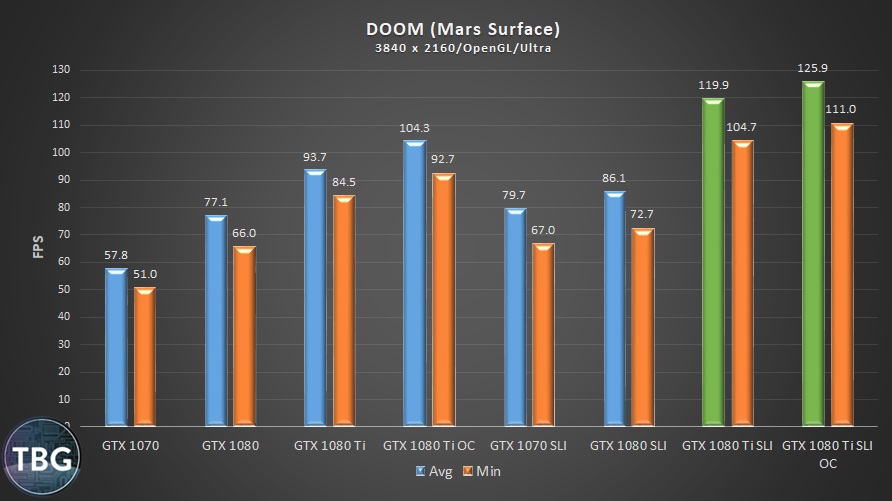
SLI scaling in this game is terrible, and in past articles, we’ve made known the fact that if DOOM is your game of choice, you simply should not upgrade to SLI exclusively to run it. Offering up a weak 28% boost over a single GPU at reference clocks, or a 21% boost once overclocked, this is the worst result of the roundup.
As an aside, we’ve found that the OpenGL renderer we used for this testing really doesn’t cope well with CPUs offering more than four cores, so our eight-core 6900K isn’t much of a benefit in this benchmark.
Battlefield 1
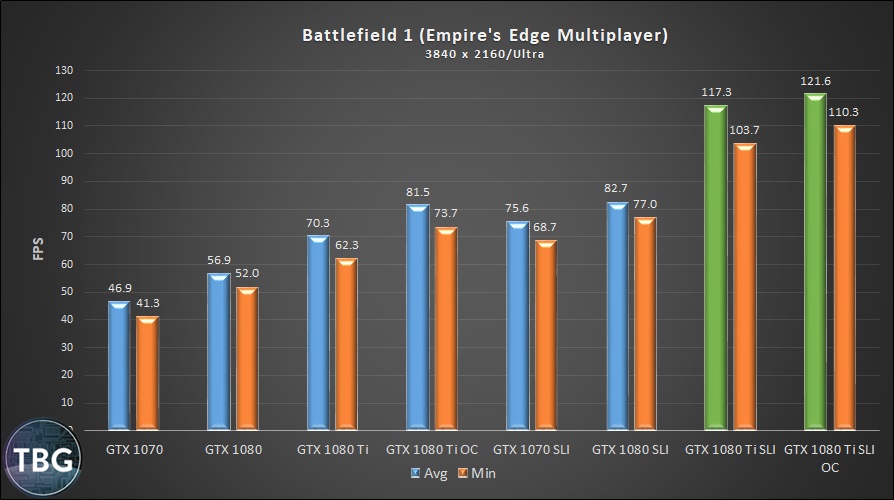
If you’re a competitive BF1 gamer looking to sink some money into a high-end system to prepare for high-refresh rate 4K monitors coming later this year, GTX 1080 Ti SLI performance will likely bring a smile to your face. While one 1080 Ti is plenty to max out any current 4K monitor, two gets you up near the 120Hz mark, where you can really achieve gaming bliss, especially when running G-Sync on those dreamy 4K 144Hz monitors that both Acer and Asus have promised to deliver. That being said, we’re still nowhere near 100% scaling here, as our overclocked duo hits just 50% in that regard.
Watch_Dogs 2
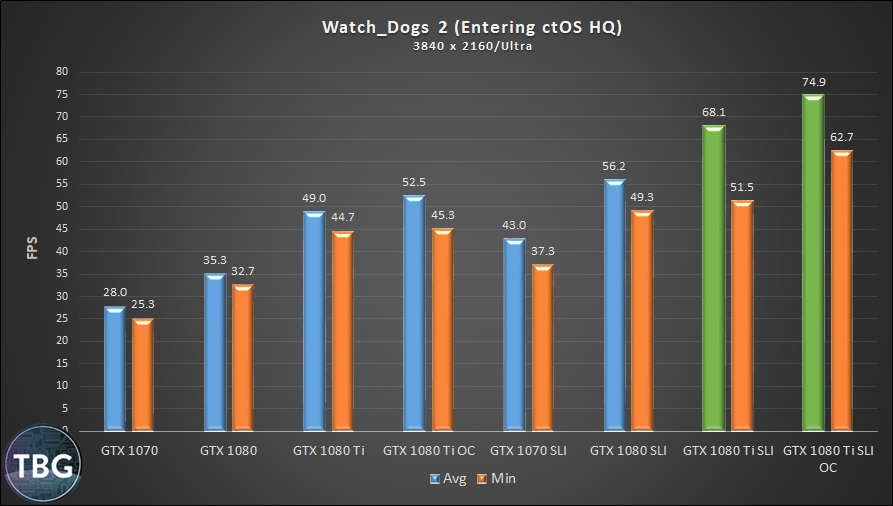
Updated after we conducted testing on our 1070 and 1080 setups, Watch_Dogs 2 proves why it’s always difficult to use a new game for benchmarking purposes. Our 1080 Ti cards were tested with the latest game patch, while the other cards used an earlier build, so the results aren’t directly comparable – the 1080 Ti has the advantage of game engine improvements. That being said, this game is still surprisingly demanding at 4K, generating the lowest framerates in our testing. Given that the 4K results for a single 1080 Ti are well below 60fps, this is a game that SLI really makes sense for, despite only modest scaling.
Average Results
If you’re buying a video card for one or two games, focusing in on the relevant benchmarks for those games is a fine approach, but if you’re buying a card for the long haul, considering performance averaged over an entire game suite is an even better approach. And as shown below, GTX 1080 Ti SLI definitely comes out looking pretty impressive:
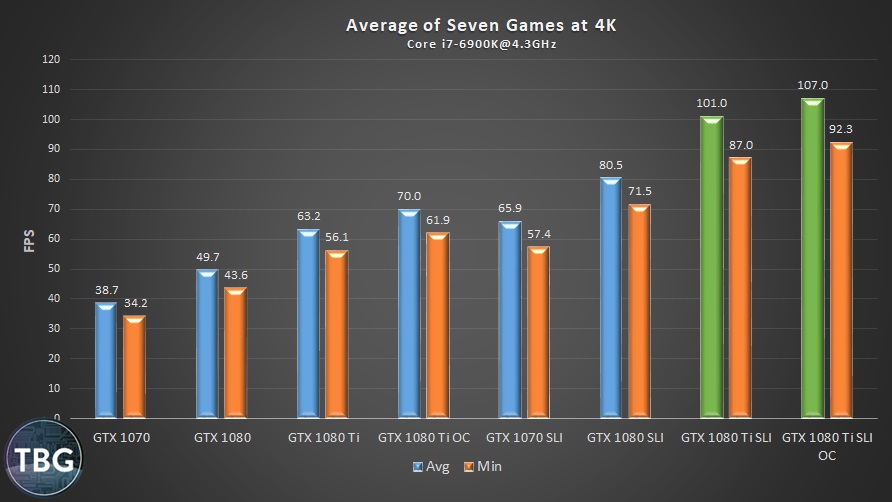
With scaling that averaged around 60%, the GTX 1080 Ti SLI duo roared past every previous GeForce setup we’ve tested, hitting a monumental 101fps average framerate in our 4K testing. As we’ve mentioned several times in this article, the benefits of such high framerates will really only make themselves known when we have more capable 4K monitors. With current-gen 4K monitors locked at 60fps, getting over 100fps in games doesn’t do a whole lot of good, but it does provide a nice bit of future-proofing!
Note that we excluded Fallout 4 from our average here, as the dynamic day/night cycles allowed the 1080 Ti to produce absurdly-high framerates since it was nighttime in the Fallout 4 world when we tested this setup (luckily, it was still daytime in the real world where we exist!).
The CPU Bottleneck
All right, it’s time to address the elephant in the room, which we’ve noted over and over again in this article: CPU bottlenecking. Oftentimes, we’ll see reviewers mention that they run their benchmarks at 4K and max out their CPU overclocks to “eliminate” bottlenecks, but when you’ve got the kind of firepower offered up by a GTX 1080 Ti SLI duo, there’s absolutely nothing you can do to get around this age-old problem. That’s because GPUs have advanced far faster than CPUs over the past few years, and even our overclocked Core i7-6900K, running at a whopping 4.3GHz, simply couldn’t keep up with the frames that the 1080 Ti SLI setup delivered.
Below we’re providing a screenshot of the Windows Task Manager during an in-game run through Rise of the Tomb Raider. A couple of important notes to keep in mind: First this is not the canned benchmark, which makes almost zero use of the CPU, but rather an actual in-game run, and second, the core clock was 4.3GHz, not 3.2GHz as reported by Windows.
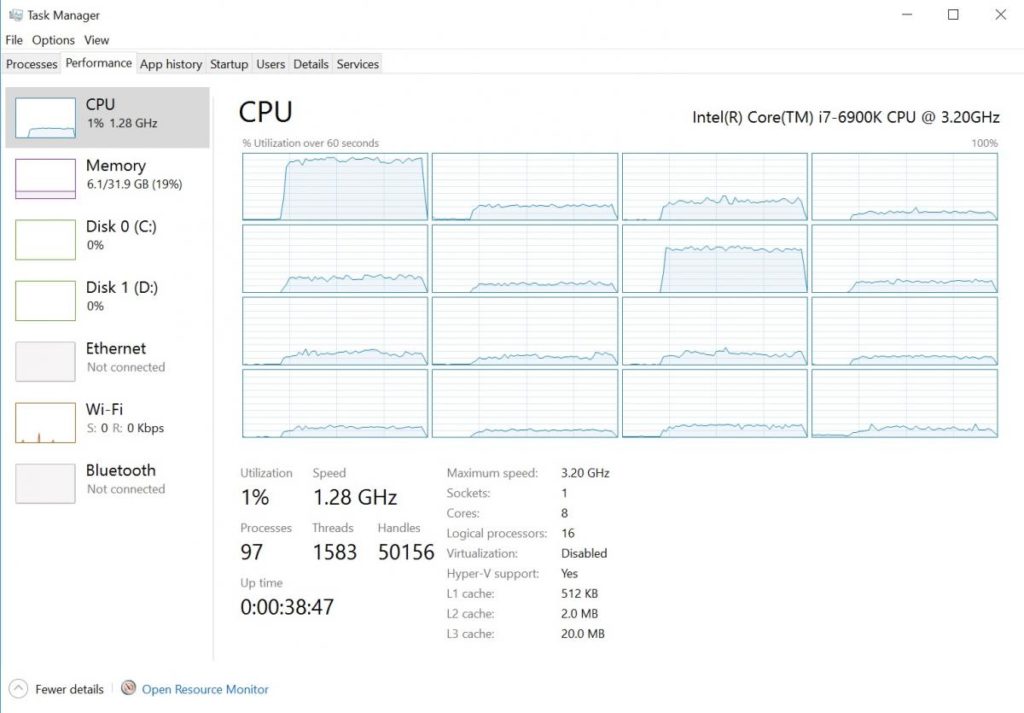
If you were to look at CPU usage in the aggregate, which you can see in the upper-left-hand corner, you’d think you couldn’t possibly have a CPU bottleneck – the CPU is only running at around 30% capacity overall. But of course, this is entirely misleading, as our core-by-core graphs prove. Core 0 on our eight-core CPU is completely maxed out, and is bottlenecking this “GPU-limited” game. In other words, when running GTX 1080 Ti SLI, Rise of the Tomb Raider is CPU-bottlenecked, not GPU-bottlenecked. That’s why we were only able to achieve 50% SLI scaling in this game, despite getting around 80% in prior SLI testing using less powerful cards.
Now, we know some people are going to say we should have tested with the Core i7-7700K, and indeed our 7700K sample, which can easily run at 5GHz, might have topped the 6900K in this test. But in reality, the Z270 platform used by that mid-range chip introduces its own bottlenecking, in the form of half the number of PCIe lanes dedicated to graphics, so we’re not convinced that stepping down to that platform is the right choice when running dual ultra-high-end GPUs. In fact, in our previous testing of the Z170 versus X99 platforms, we found that the greater PCIe bandwidth provided by the X99 platform evened the playing field, even though quad-core CPUs on the Z170 platform offered up a bit more raw single-threaded speed. Furthermore, you’d lose out in truly multi-threaded games, like Battlefield 1, which we’ve found to run much faster on eight-core processors, even when clocked lower than four-core processors.
Cooling, Noise, and Power Use
While this article wasn’t meant to be a full-on review, we thought we’d touch upon a few factors that may be of concern to enthusiasts considering a high-powered SLI setup: cooling, noise, and power. As we found when running a custom fan profile to keep our GPUs from hitting the 84 °C thermal throttling threshold, this system could get pretty loud. During our benchmarking of Witcher 3, which taxes GPUs to an extreme degree, we hit 80 °C on our top card and 74 °C on our lower card, with fan speeds hitting 80% and 62% respectively. This generated a noise level reading of 50 dB measured six inches in front of the case. When we overclocked the GPUs, the temperatures increased by 1 °C on both GPUs, and the noise level went up to 50.5 dB due to the slightly faster fan speeds required to keep the temperatures under control. To learn how to tame this savage beast, check out our follow-up review of the EVGA Hybrid cooler for the 1080 Ti.
To test power use, we use 3DMark Combined, which pushes the GPUs to near 100% capacity due to excellent scaling, while also taxing the CPU significantly.
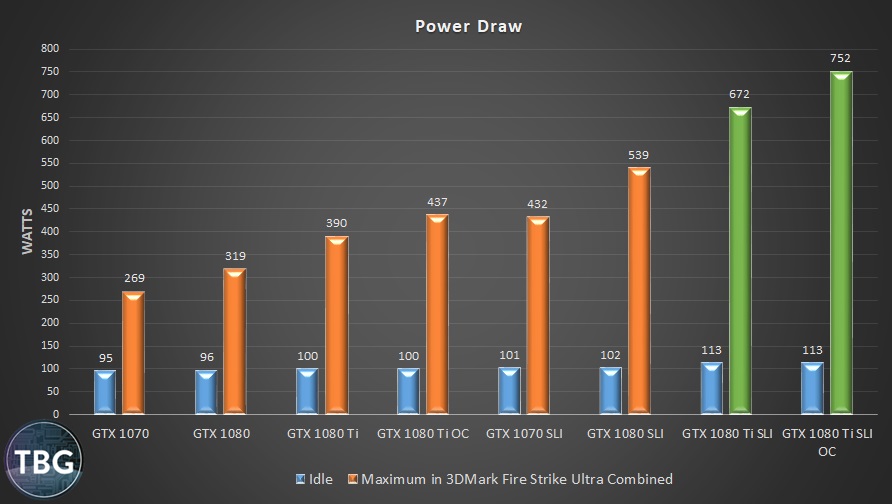
Well, you’d best have a very stout power supply if you’re going to be running a setup like this one. Keep in mind that we have a highly-overclocked Core i7-6900K processor in our benchmarking rig, so it contributes significantly to the power use. That being said, it’s pretty clear that GTX 1080 Ti SLI draws power like no other SLI setup. You’ll need at least a 1000W PSU to support a gaming system like this. You might think you could get away with an 850W unit, but we’d caution you that it will be running at the ragged edge of stability, and well outside of its peak efficiency level.
Conclusion
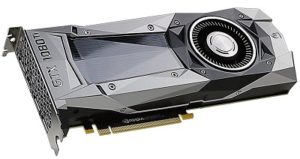
There’s really no doubt about it: a GeForce GTX 1080 Ti 11GB SLI setup is able to conquer any game, even when running at the ultra-high-def resolution of 4K. Gamers looking for the ultimate 4K gaming experience will definitely want to consider making the leap, and anyone even considering investing in the forthcoming 144Hz 4K monitors should add a couple of 1080 Ti GPUs to the budget, as no single GPU will be able to make proper use of such a monitor.
The fly in the ointment for 1080 Ti SLI, however, is CPU bottlenecking. The 1080 Ti is such a powerful GPU that when running two in SLI, it’s just too fast for current CPUs to handle. That means a bit of performance is going to be left on the table. Hopefully we’ll be seeing more powerful CPUs in the near future, but with many games still taxing one core far more than the rest, we’re not all that confident that this bottleneck will be alleviated anytime soon. This article is being published on the eve of Computex 2017, and we already know that both AMD and Intel are going to be trying to win the hearts and minds of gamers everywhere with their massively multi-cored CPUs. Will 12, 14, or 16 cores really help gamers all that much if instructions per clock cycle stay stagnant? We doubt it. And that’s what we’re likely to see with “Skylake-X”, “Kaby Lake-X”, and “Threadripper” CPUs. None of these is actually going to exceed the IPC efficiency of the Kaby-Lake-based quad-core i7-7700K, and at stock speeds, most will be slower than our system, which used a Core i7-6900K@4.3GHz. A renewal of competition in the CPU market had bred progress, however, and progress is good. That being said, more progress would be even better….
To see more gamer-focused content, check out our Gamer’s Bench. For our latest video card recommendations, check out our Video Card Buyer’s Guide. And as always, you can see all of our current PC component recommendations in our Do-It-Yourself PC Buyer’s Guides, which help gamers squeeze every last bit of performance out of their systems, regardless of budget!
